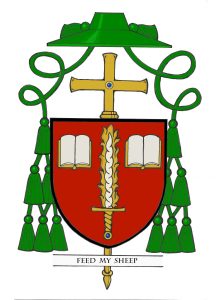Bishop Michael A. Saporito, D.D.
Biography
The son of the late Arsenio and Anna Saporito, Bishop Michael A. Saporito was born on May 3, 1962, in Newark and raised in Bloomfield, New Jersey. He is the third of four children, a sister who is deceased and his two brothers and their families, who reside in New Jersey.
Bishop Saporito attended St. Thomas the Apostle Elementary School in Bloomfield and, in 1980, graduated from Paul VI Regional High School in Clifton. Graduating from Rutgers University Newark in 1984 with a Bachelor of Arts in Accounting, he was employed in public accounting for three years after graduation. He entered Immaculate Conception Seminary at Seton Hall University in September of 1987 and was ordained a priest on May 30, 1992.
Bishop Saporito has served in parishes of the Archdiocese of Newark throughout his years in ministry. He has served as Parochial Vicar at St. Joseph’s Church in West Orange, St. Peter the Apostle in River Edge, Our Lady of the Visitation in Paramus, and St Elizabeth in Wyckoff.
In May of 2004, he was appointed Pastor of St. Joseph’s in Maplewood, where he served for almost seven years before being named Pastor of St. Helen’s in Westfield in February of 2011.
In the course of his ministry, Bishop Saporito has served in numerous capacities as an assistant vocation director, and as a member of both the Priest Personnel Board as well as the Presbyteral Council. He was the Dean of the Deanery covering Maplewood, South Orange and Irvington.
In recent years, Bishop Saporito has been most devoted to the New Evangelization, offering programs of faith development and awakening people to a deeper faith in Jesus Christ, while working tirelessly to foster parish renewal and intentional discipleship. He has served on the Evangelization Commission of the Archdiocese of Newark and as a Board Member for Christlife, an Evangelization apostolate of the Archdiocese of Baltimore, Maryland.
On February 27, 2020, His Holiness, Pope Francis named Reverend Michael A. Saporito as an Auxiliary Bishop of the Archdiocese of Newark.
Coat of Arms
 Blazon: Gules, a flaming sword palewise, point in chief, the blade Argent, enflamed Or, the hilt and pommel Or with a pommel stone Azure, between to dexter and sinister two open books Argent, bound Or. Shield ensigned with an episcopal cross Or behind the shield and a bishop’s galero Vert cords and twelve tassels disposed in three rows of one, two and three all Vert. On a scroll below the shield the motto: “Feed My Sheep”.
Blazon: Gules, a flaming sword palewise, point in chief, the blade Argent, enflamed Or, the hilt and pommel Or with a pommel stone Azure, between to dexter and sinister two open books Argent, bound Or. Shield ensigned with an episcopal cross Or behind the shield and a bishop’s galero Vert cords and twelve tassels disposed in three rows of one, two and three all Vert. On a scroll below the shield the motto: “Feed My Sheep”.
Explanation: Bishop Saporito has chosen a coat of arms reflecting his priestly life and ministry. The red background is borrowed from the coat of arms of the Archdio-cese of Newark where the upper third of that shield (called a chief) is colored red. The bishop’s whole life, priesthood and, now, episcopate has been spent in the service of the Archdiocese.
The central symbol, or charge, is the flaming sword that is used as a symbol of his bap-tismal patron, St. Michael the Archangel. Michael, reckoned as the commander of the heavenly hosts wields the sword that symbolizes righteousness and God’s justice.
The sword, with a silver blade surrounded by golden flames and gold handle has two open books on either side. The pages of the books are blank and silver (white) while the books are bound in gold (yellow). These symbolize the Sacred Scriptures in both Testaments and are a reminder of the need for and the work of evangelization in the Church. The Bishop has devoted a part of his priestly ministry to the New Evangeliza-tion.
The motto below the shield is “Feed My Sheep” (John 21:17)
The shield is also ensigned with those external ornaments that indicate the bearer is a bishop. The gold (yellow) episcopal cross, not to be confused with a processional cross, is placed vertically behind and extending above and below the shield. In former times archbishops, and later all bishops, had a cross mounted on a staff carried imme-diately in front of them while in procession or on solemn occasions. This cross was a symbol of their rank as bishop. While such an episcopal cross is no longer used prac-tically it has been retained heraldically. In fact, there are other clerics who make use of the ecclesiastical hat with its many tassels but the one true heraldic emblem of a bish-op, and the only essential one, is the episcopal cross placed behind the shield.
Above the shield is the ecclesiastical hat, called a galero which, in heraldry, replaces the martial helmet, mantling and crest. “The hat with six pendant tassels (green, purple or black) on each side is universally considered in heraldry as the sign of prelacy. It, therefore, pertains to all who are actually prelates.” (Heim, Bruno B., Heraldry in the Catholic Church 1978, page 114) The galero is green with green cords pendant from it and twelve green tassels arranged in a pyramid shape on either side of the shield. At one time in history bishops and archbishops wore green before adopting the more Roman purple we see today. In heraldry the green hat and tassels was retained for prelates with the rank of bishop according to the Instruction of the Secretariat of State, “Ut Sive” of March, 1969.
The armorial bearings of Bishop Saporito were designed, blazoned and rendered by the Rev. Guy Selvester a priest of the Diocese of Metuchen, New Jersey.
